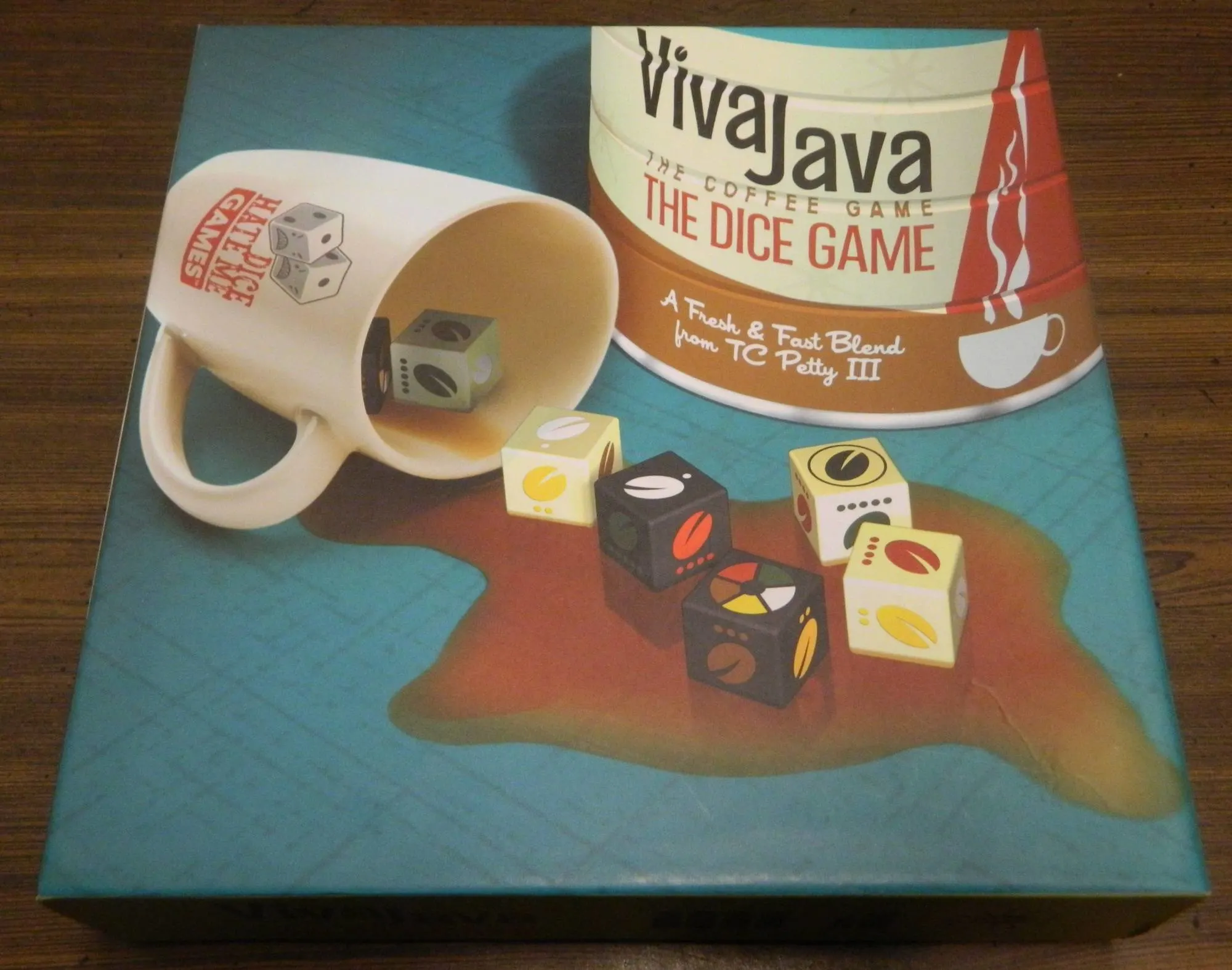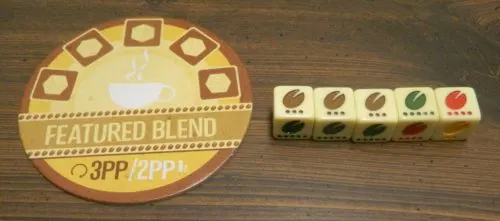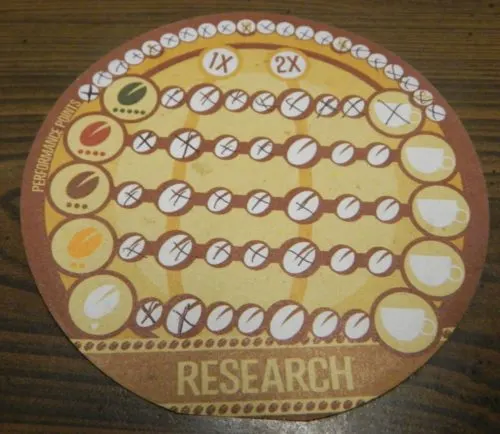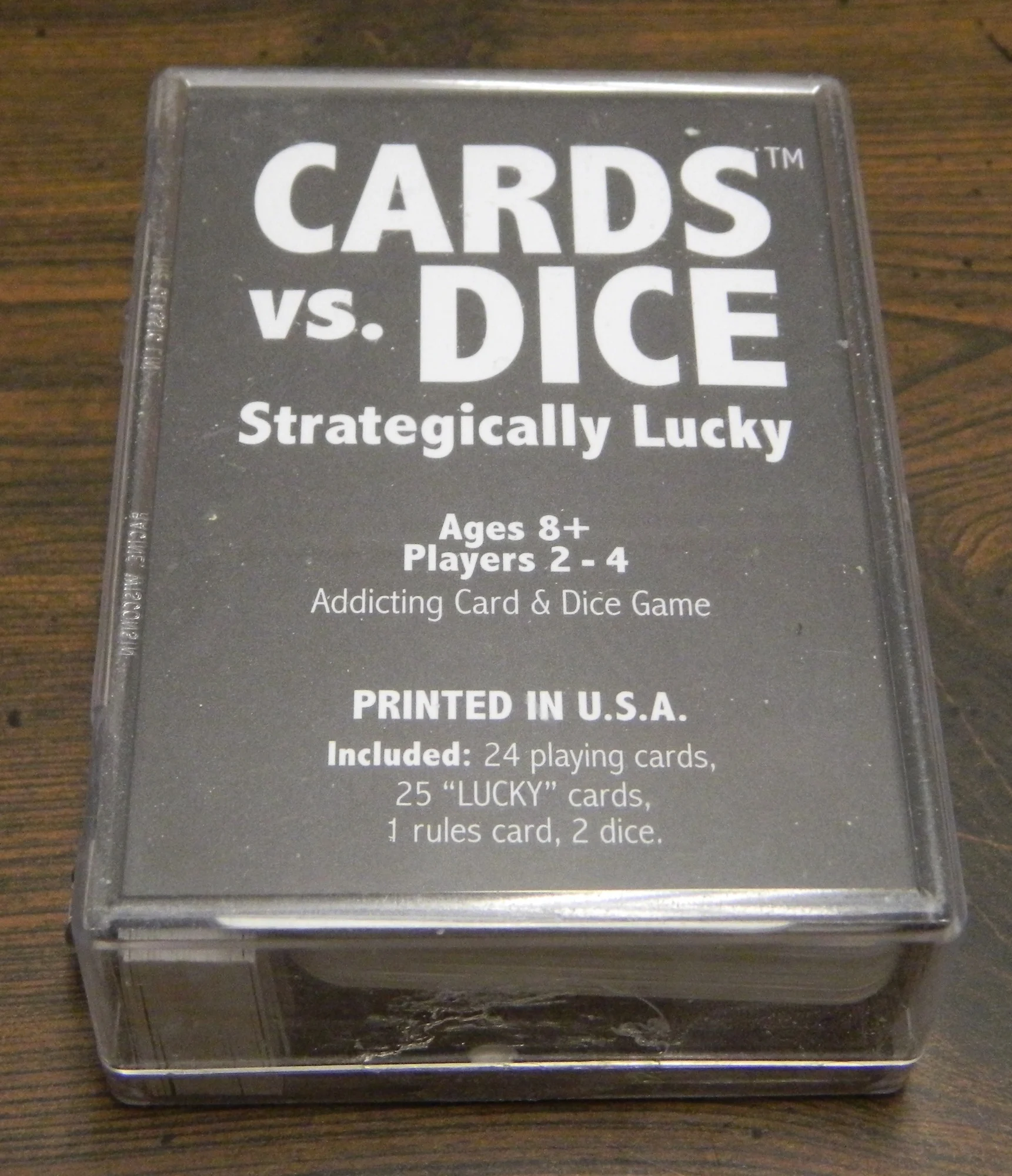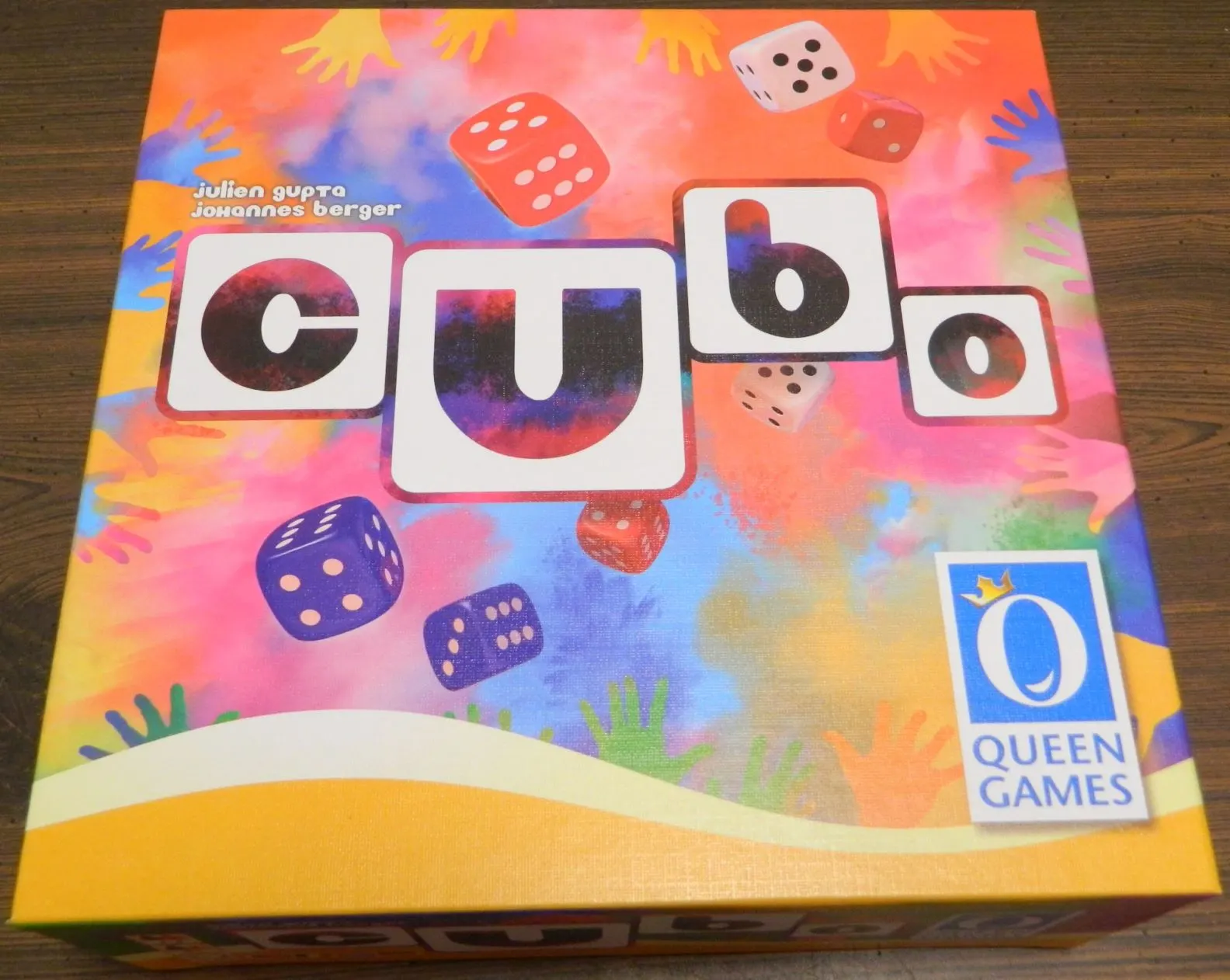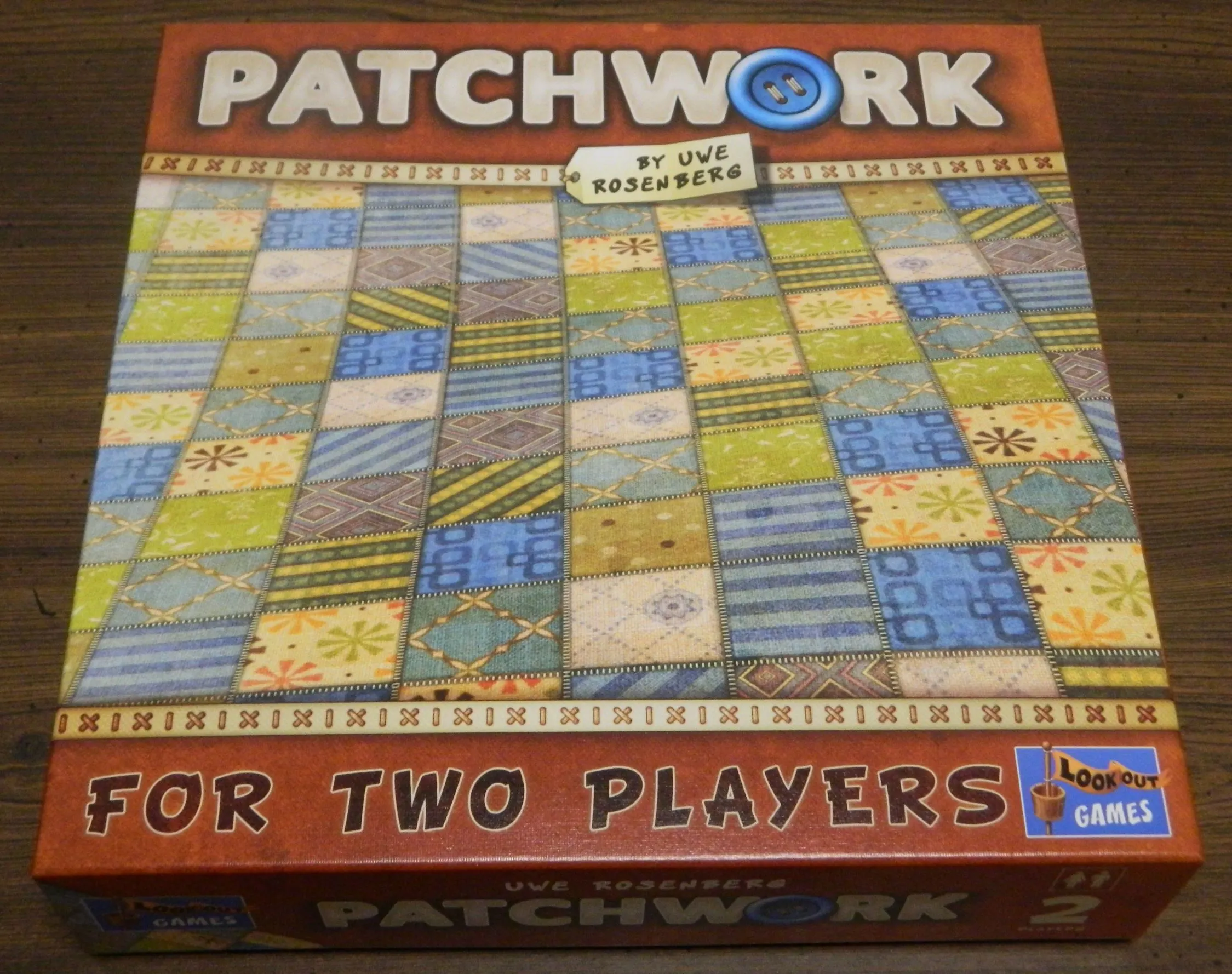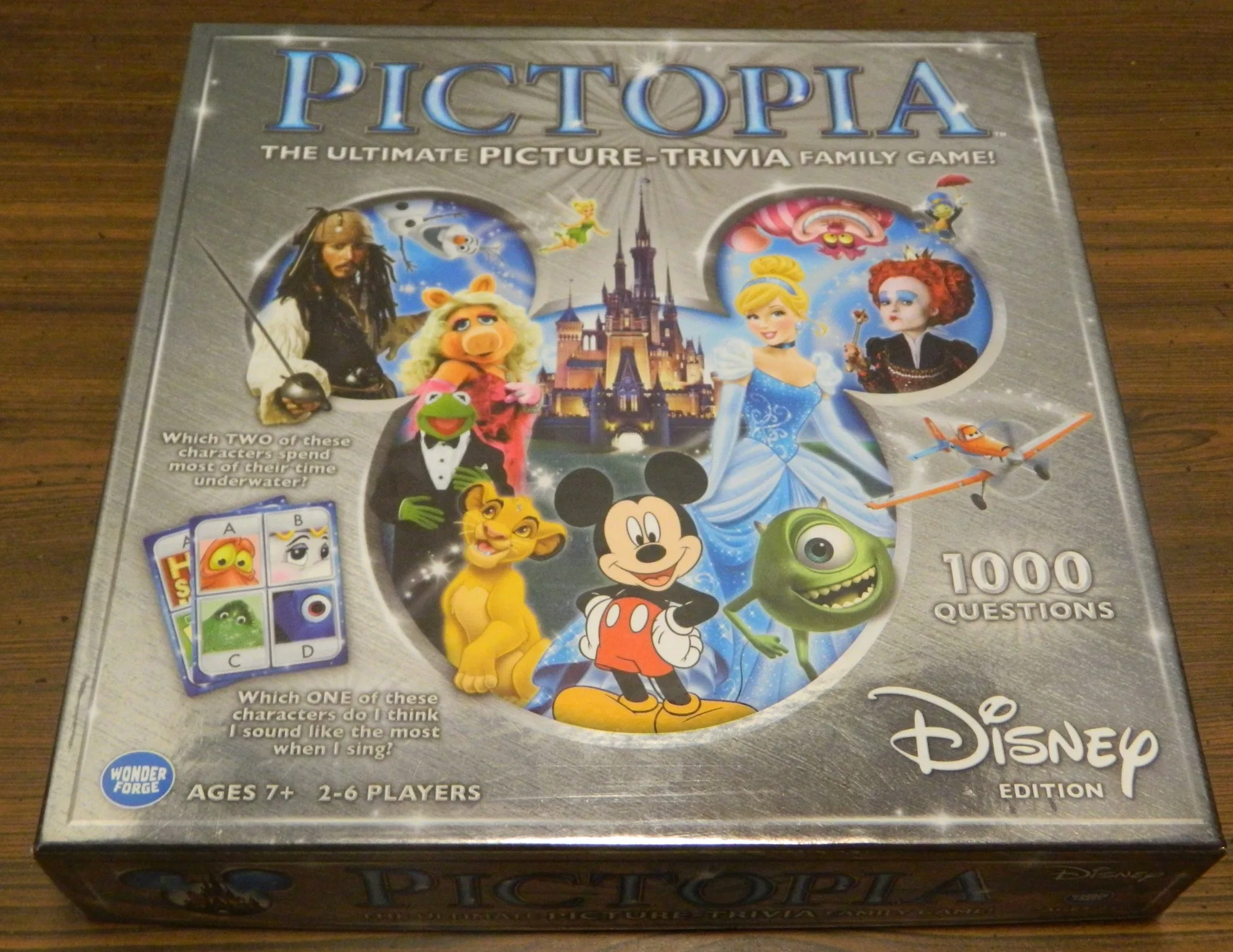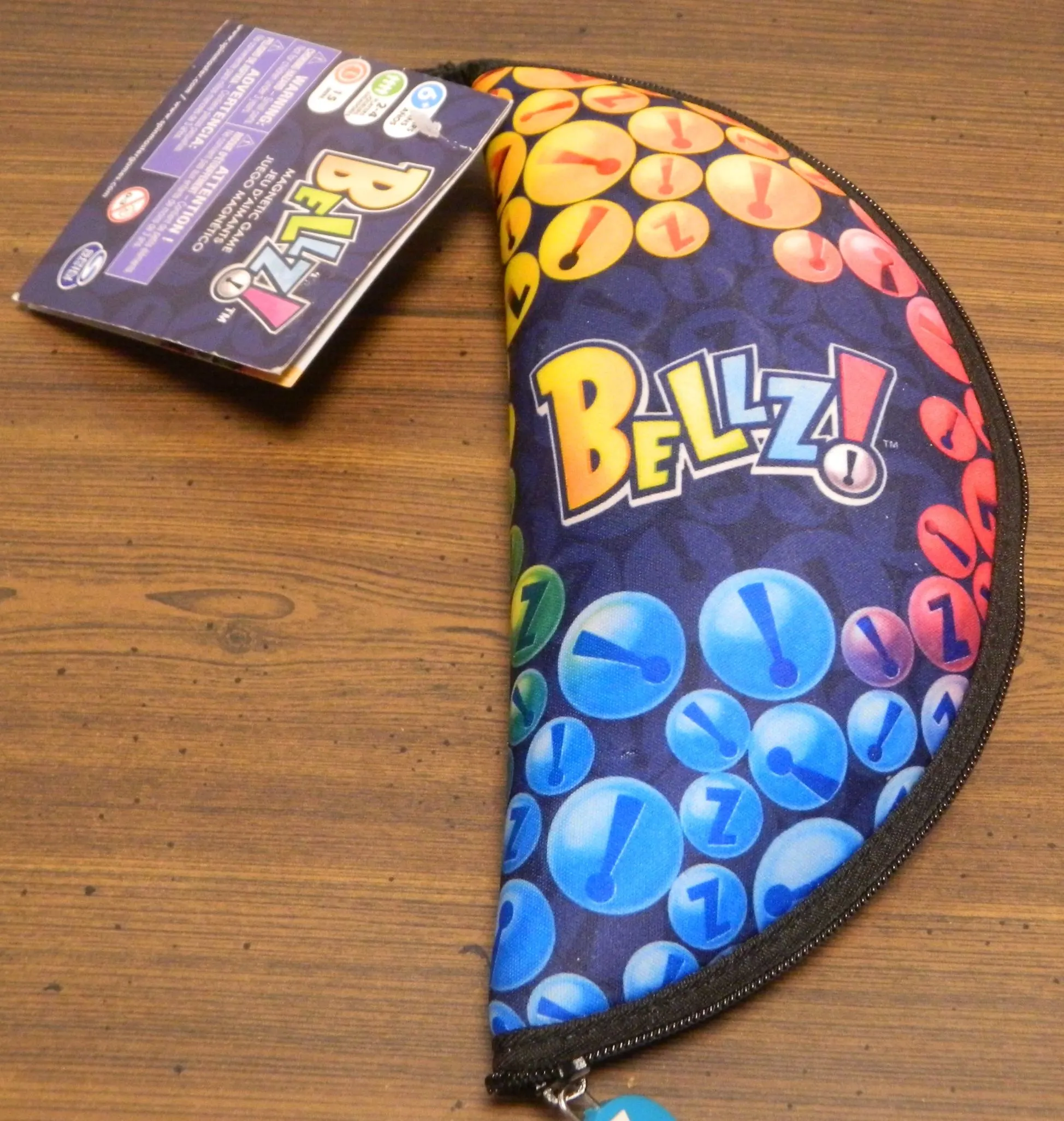Released back in 2012, VivaJava: The Coffee Game was a pretty well regarded worker placement style game where players worked for a coffee company whose goal was to make the best coffee. Like quite a few designer games recently, the designer decided to take the original heavier strategic game and streamline it into a dice game in order to appeal to a more broad audience which ended up becoming the 2014 dice game VivaJava: The Coffee Game: The Dice Game. For the most part a lot of these dice game spinoffs of popular designer board games have actually done pretty well even though few of them are as good as the original games. I was a little surprised to actually see that VivaJava: The Dice Game was actually rated higher on Board Game Geek than the original game. While I have not yet played the original game, this intrigued me. While VivaJava: The Dice Game is not a perfect game, it does a good job blending a simplistic dice game with mechanics from more strategic board game to create a fun and original dice game.
How to Play VivaJava: The Coffee Game: The Dice Game
Setup
- Place the ten coffee dice next to each other in the middle of the table.
- Place the five flavor dice on the flavor coaster.
- Place the featured blend and rainbow blend coasters in the middle of the table where everyone can reach them.
- Choose one of the research coasters (LITE is recommended for your first game) to use for the game and place it in the middle of the table.
- Each player takes a player reference coaster and three tokens of their chosen color. They also take a score/research sheet and a writing utensil.
- Each player rolls one coffee die to determine the first player. Whichever player rolls the most valuable bean gets to play first. If two players tie for the highest value, they roll their die again. All of the players, other than the first player, get to cross off one RP spot of the color bean they rolled.
Playing the Game
A player’s turn consists of three phases:
- Score
- Roll
- Activate
Scoring
At the beginning of a player’s turn they check to see if they have scored any points. If a player doesn’t have the featured blend or rainbow blend coaster in front of them, they score no points during this stage.
If a player has a rainbow or featured blend in front of them, they will score the number of victory points indicated on the bottom of the coaster corresponding to the number of players in the game. If the player controls a rainbow blend, the scoring phase ends at this point and the player gets to keep the rainbow blend coaster in front of themselves.
If the player scored from a featured blend they will now have to degrade the blend. The player has to discard one of the dice from the coaster (their choice). The player then needs to decide whether they are going to keep the blend together or whether they are going to break it up. If a player decides to keep the blend they will keep the coaster in front of themselves and will skip the rest of their turn. If the player decides to break up the blend they will give up the featured blend coaster but will get to roll all of the dice remaining on the featured blend coaster.
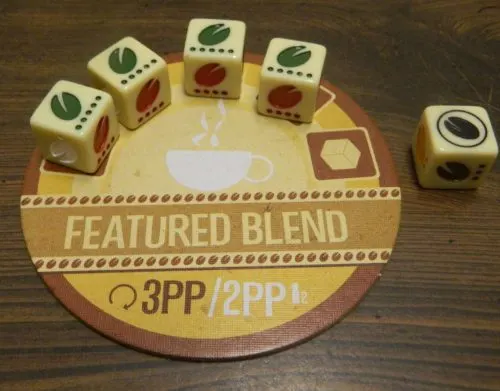
This player has degraded their featured blend by getting rid of the black bean die. This player will likely want to keep their featured blend around for their next turn.
Roll
After the score phase the player takes five coffee dice and rolls them. If a player has any flavor dice (black dice) they must roll all of them as well. If a player has any unlocked research abilities that can be used to affect their roll they can use them at this point. The player analyzes the beans they rolled and can then use their dice for one of two actions: blend or research.
Blend
If the player rolled the right combination of beans they may be able to make one of two different types of blends.
Featured Blend
For a featured blend the player uses beans of the same color. To create a featured blend a player has to use at least two beans of the same color.
As only one player can control the featured blend at a time, players need to compare the value of their featured blend against the current featured blend if there is one. When comparing two featured blends you need to look at the robustness and quality.
The first criteria is robustness. Basically a blend with more beans of the same color is more valuable than a blend with less beans of the same color.
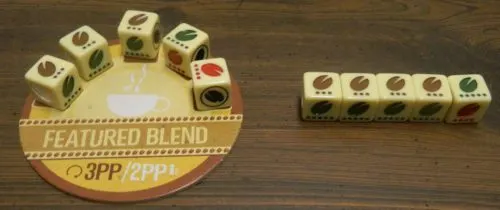
The current blend has a robustness of three brown beans. The new blend has a robustness of four brown beans so it would take control of the featured blend coaster.
If two featured blends have the same number of matching dice, you then look at the quality. A blend featuring more valuable beans is worth more than a blend with less valuable beans. The ranking of the bean colors is as follows (from least valuable to most valuable): white, yellow, brown, red, green, black. The value of each bean can also be determined by the number of pips under the bean with the black circle being the most valuable.
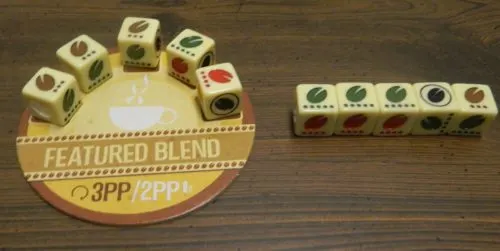
Both blends have the same robustness as both blends have three dice of the same color. The blend with three green dice would take the featured blend coaster though since the green beans are more valuable than the brown beans.
If the current player’s feature blend is more valuable than the current featured blend or there is no current featured blend, the current player takes control of the featured blend coaster. A player places the dice they rolled on the featured blend coaster to indicate the current featured blend that the other players have to beat. If any flavor dice are used in the blend the player takes a normal coffee dice and turns it to the side of the flavor dice so the flavor dice can be returned to the flavor dice coaster. The player automatically scores one victory point for creating a featured blend and keeps the coaster in front of them in case they score more points from the blend on future turns.
Rainbow Blend
To create a rainbow blend a player has to roll beans of five different colors. If a player rolls five different colors they take the rainbow blend coaster and automatically score one victory point. The dice used for the blend are returned to the middle of the table.
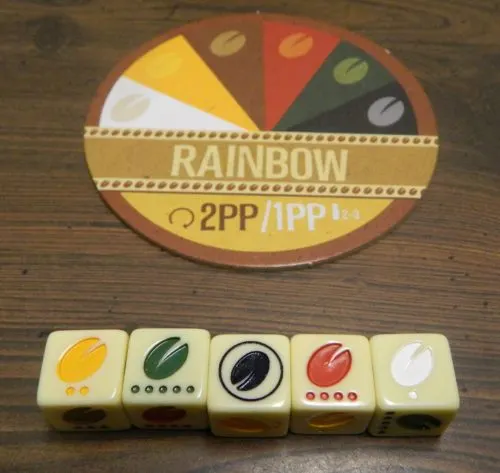
This player has created a rainbow blend because they have rolled five different colors on their dice.
Players can only control one blend at a time. If a player already controls the rainbow blend but rolls a featured blend strong enough to take the featured blend coaster, they must get rid of the rainbow blend to take it. A player cannot roll another rainbow blend if they already control the rainbow blend coaster.
Research
Instead of creating a blend, players can use their dice in order to research. A player sorts their dice by color. The player then chooses one of the colors of beans to use for research. The player will get one research point in the color they chose for each dice of that color that they rolled.
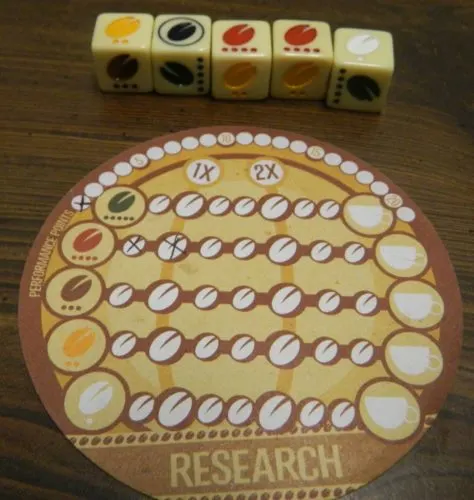
This player has chosen to use their turn to research. The player has rolled two red beans so they are able to cross off two of the beans on the red track.
If a player chooses to research with their black beans they will take as many flavor dice as black beans they rolled in the round. A player can use a flavor die in two ways. First if they have any flavor dice at the beginning of their turn they must roll them.
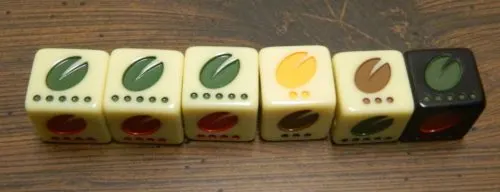
This player has rolled one flavor die on their turn. They can use the green bean that they rolled and combine it with the other three green beans they rolled in order to make a featured blend.
Otherwise the player can choose to roll their flavor dice on another player’s turn. If the current player decides to use any of the flavor dice rolled by this other player they will score one victory point. All flavor dice not used by the current player can be reused by the player that controls them. If the player that created the blend ends up scoring more points from it, the player whose flavor dice were used will score one victory point for each of their flavor dice the other player used.
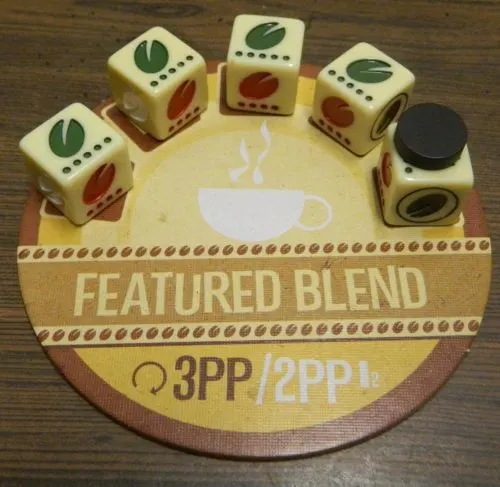
A player has ended up donating one of their rolled flavor dice to this player. The player whose die was donated will receive one point when the featured blend scores.
Each bean color (other than black) has three different levels. When a player crosses off enough beans to reach the 1X spot, the player has access to the ability associated with the color of bean that reached the 1X spot. All abilities that don’t involve receiving a token can be used every turn for the rest of the game. Once a player reaches the 2X spot they can perform the special ability twice on their turn.
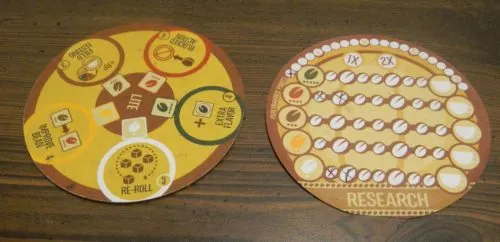
The player has unlocked the first level of the re-roll and block action abilities. This player is able to re-roll their dice once on their turn and is able to block an action for all of the other players for one turn.
When a player crosses off the final space for one of the research tracks, the player will score victory points equal to the value of that bean color. Once a player claims the victory points though they will no longer be able to take advantage of the special ability associated with that bean color.
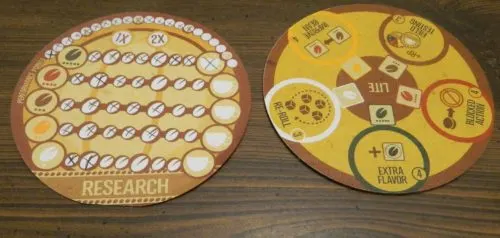
This player has completed the research track for the green bean. They will receive four victory points but they will lose access to the extra flavor ability.
Activate
After a player has blended or researched with their dice, they check to see if they have gained any new abilities from their research. If a player has gained an ability that has you “gain a token” you take the token at this point. Players can also use abilities that can only be used during the activate stage at this time.
When a player has finished, play passes to the player to the left.
End of Game
The game ends immediately after one of the players has scored 21 victory points. That player has won the game.
My Thoughts on VivaJava: The Coffee Game: The Dice Game
At it’s most basic level, VivaJava: The Dice Game is a basic dice rolling game. Just like with games like Yahtzee, the goal is to roll as many of the same number/color as you can in a round in order to score more points. In general I would say I don’t mind the occasional dice game but I am always looking dice games that add a little more to the formula. Games like Yahtzee are fine but you don’t have a lot of control over your fate in the game. There are some risk/reward elements but for the most part these type of dice games come down to luck. Roll well and you will do well in the game. Roll poorly and you have little chance of winning.
So if I left VivaJava: The Dice Game at this point it would be a solid dice game but it wouldn’t be very special. The good news though is that VivaJava has a lot more to it than your average dice rolling game. I think the best way to describe VivaJava: The Dice Game is to say that it is what you would get if you mixed your typical dice rolling game with a strategy game. While the game still relies on quite a bit of luck (as you are still rolling dice after all), the game gives you a lot of options of how you can manipulate your rolls in order to improve your final roll.
The biggest mechanic in my opinion in VivaJava: The Dice Game is the idea of research. There are so many things that I like about this mechanic as it gives quite a bit of control back to the players. While luck still plays a role in doing well in the game, you can find ways to supplement your luck by researching the right upgrades. You can research and get the ability to re-roll dice or even outright change the face up side of the dice. With enough abilities you can really start to have control over your dice rolls to the point where luck doesn’t have nearly as much of an impact on the game.
While I think some of the special abilities are better than others, I give the game credit for having a wide variety of them. While you should play your first game with the LITE research coaster, when you are more familiar with the game you get access to a lot more special abilities. You can even use a wild coaster where you randomly pick what special ability each color bean gives you. The special abilities range from letting you re-roll dice, changing what side is face up on a dice, adding more power to your research efforts, and even letting you mess with your opponents. With so many different special abilities and the ability to mix and match them there are so many potential strategies in the game. For a dice game there is quite a bit of strategy in the game.
I think the best side effect of the research mechanic is the fact that a player will always be able to do something with their roll. In a lot of dice rolling games you will either have a useful roll or your turn will be a total waste. While some rolls are more valuable than others in VivaJava: The Dice Game, you will always be able to do something with your turn. Roll well enough to claim one of the blend coasters and you will score some points. Otherwise you can use some of your dice in order to research and gain abilities that will help you in future turns. The fact that everything has some value even applies to the dice themselves. For example while the white beans are the least valuable bean when it comes to creating blends, they actually give you one of the best special abilities through research as they let you re-roll dice.
I think most people’s strategies in VivaJava: The Dice Game are going to feature a lot of research early in the game. If you are able to roll well enough to claim one of the blends, you will probably claim the blend since it is always good to put points on the board. Early in the game though you likely will end up with a lot of rolls that won’t let you claim a blend. In this case you will use your turns in order to research. By researching you open up additional opportunities which make it easier to get better rolls on future turns. After you have access to a lot of the special abilities you are going to focus more on creating blends since with the special abilities you can usually make some pretty strong blends pretty easily. When you approach the end game another opportunity presents itself though.
This new opportunity is the fact that you can cash in your abilities in order to score more points. Basically when you fill in all of the research for a given bean color, you will receive points. By taking these points though you have to give up the special ability associated with that color bean. While I actually see some players pursuing a strategy of getting a lot of points from cashing in research (there are actually some special abilities that encourage this), I personally prefer using research in order to receive the special abilities. I like having more options in the game so I want to use the special abilities for as long as possible. When you get to the end of the game though you really need to start considering this option. You can gain a lot of points quickly by cashing in a couple abilities. If you are only a couple points away from winning you might be able to cash in an ability to earn enough points to win the game.
The problem that I have with most dice games is that there really aren’t a lot of decisions to make. In most dice games you are just deciding on whether to press your luck and what dice you are going to re-roll. Usually these decisions are pretty obvious so it doesn’t feel like you have a lot of impact on the final outcome of the game. What I like about VivaJava: The Dice Game though is the fact that the game gives you many different ways to approach the game. You can either go for points right away or you can focus on research to get yourself more abilities to help yourself later in the game. While there is still a reliance on luck, it feels like your decisions really have an impact on the game.
Not being a coffee drinker myself I have to say that the coffee theme of VivaJava: The Dice Game didn’t really appeal to me that much at first. With how many avid coffee drinkers that are out there I have to admit that I am kind of surprised that there aren’t more board games with a coffee theme. While the coffee theme didn’t really appeal to me that much, I give the game credit for doing a pretty good job with it. The theme is not always the strongest in the game but I have to give it a lot of credit for putting a solid theme on a dice rolling game.
While I haven’t personally played it yet I give VivaJava: The Dice Game a lot of credit for actually devising a special single player mode for the game. Instead of having a player just play as several different people, the single player game involves the player competing against an evil corporation. The corporation that the player plays against has set rules which makes it really easy to figure out how to handle the competition’s rolls. While I think the regular game will still be more enjoyable, I actually think the single player mode is better than you could expect from most single player board game experiences.
For the most part I really like the components. For a dice game you actually get a surprising amount of stuff in VivaJava: The Dice Game. The dice aren’t flashy but they are pretty high quality dice. The artwork is somewhat simplistic and yet works quite well for the game’s theme. As I already mentioned I really like how many special abilities and add-ons that the game has which adds a lot of replay value to the game. While I really like the components I do have one small issue. I really wish the game would have given players some way of easily indicating which special abilities they had available to them. While you can look at your scoresheet I think it would have been beneficial having something to place on the research coaster so a player could quickly see what special abilities they had open to them.
There is a lot that I really like about VivaJava: The Dice Game but it does have some issues as well.
The biggest problem in my opinion is the fact that there is the occasional runaway leader issue. If a player gets a really good roll they can gain a quick lead in the game and make it hard for the other players to catch up. A good roll for the featured blend for example can lead to a player controlling the featured blend for several rounds. For example if a player controls the featured blend for three rounds they could end up scoring up to ten points. As you only need 21 points to win the game, one roll can almost put you halfway towards winning the entire game. This forces all of the other players to try and gang up on the leader to try and catch up. While this is sometimes successful, if a player gets out to too big of lead there is no way the other players are going to catch up.
The other issue I had with VivaJava: The Dice Game is the fact that the game takes a while to fully grasp. This is a little odd since once you know how to play the game it is actually quite straightforward. I would say that it will take most players a couple rounds before they fully know what they are doing. This is a shame since it might turn off some people that otherwise would really enjoy the game. I attribute this to two factors. First the instructions could have been written better. The rules aren’t terrible but I think they could have been a little more straightforward. The other issue comes from the fact that there are actually quite a few different things you have to keep track of in the game especially for a dice rolling game. Once you get used to playing the game this isn’t a big problem but it does make VivaJava: The Dice game one of those games that you need to get used to before you can fully appreciate it.
Should You Buy VivaJava: The Coffee Game: The Dice Game?
In general I wouldn’t say that I love or hate the dice rolling genre. Dice rolling games can be fun but too often they rely too much on luck in order to win. VivaJava: The Dice Game is an interesting dice game though because it kind of blends a traditional dice rolling game with a more strategic board game. The mechanic that really makes the game stand out is the fact that you can research and thus gain additional benefits that you can use to help you on future turns. No longer are there wasted turns as you will gain some benefit out of every dice roll. The game really succeeds in giving you multiple ways of approaching the game which make you feel like you truly have an impact on the game. VivaJava: The Dice Game does have a runaway leader problem though and it does take awhile to fully appreciate everything the game has to offer. VivaJava: The Dice Game is still a great dice game.
While I liked VivaJava: The Dice Game quite a bit I will admit that it is not going to be for everyone. If you hate dice games, it probably won’t be for you. Also if you are more of a casual board game player and don’t really care for all of the additional mechanics in the game, it might not be for you. If you are looking for a more strategic dice rolling game though that actually gives you quite a few decisions I think you will like the game quite a bit. If that describes you I would recommend that you pick up VivaJava: The Dice Game.
If you would like to purchase VivaJava: The Dice Game you can find it online: Amazon, eBay

